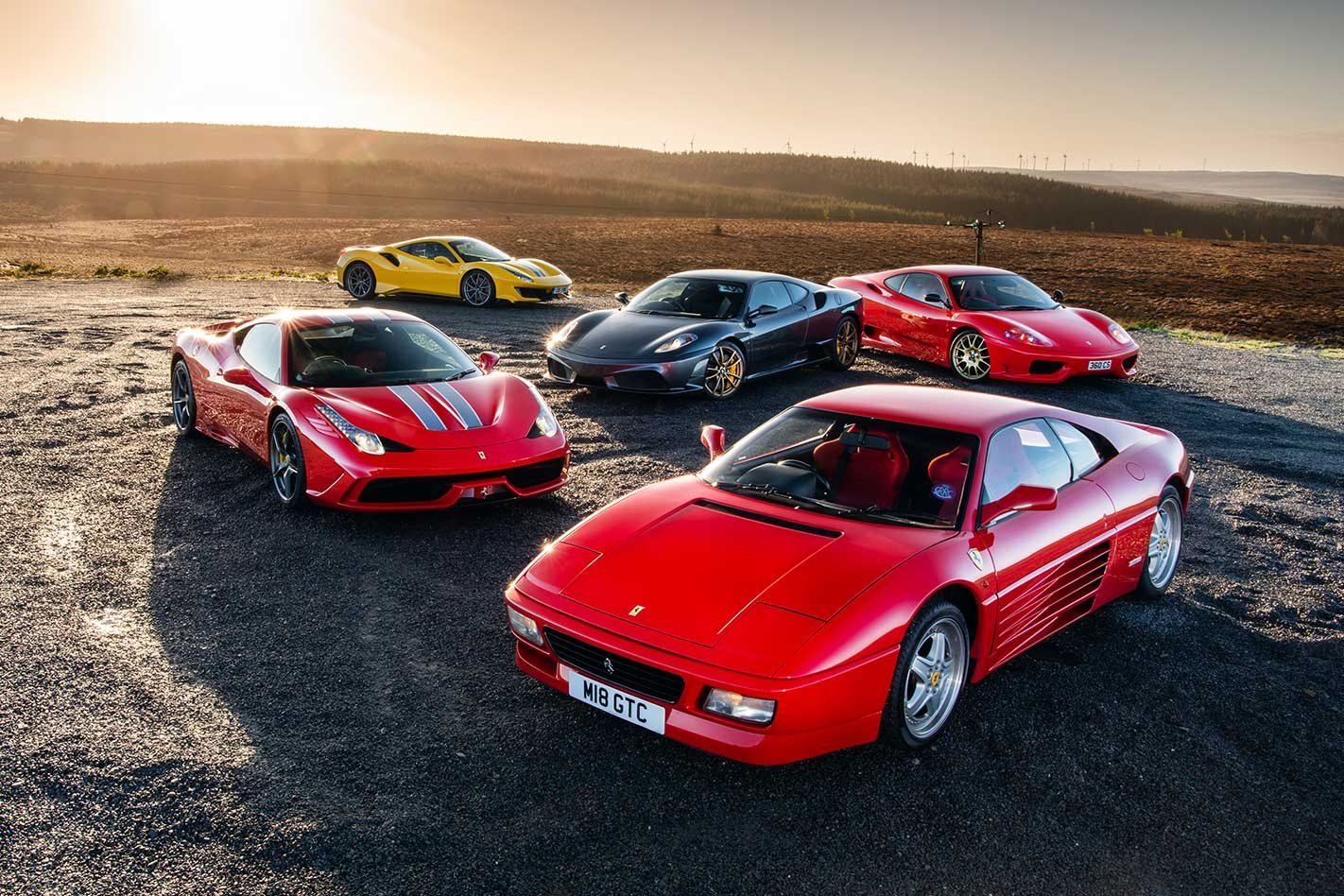Top of the list of things I don’t want to hear at 4.15am is my alarm clock. Today, a very close second is the heavy patter of raindrops.
That was emphatically not in the forecast. Judging by the demeanour of our guesthouse owner, I’m guessing that a new entry at the top of her own list is the high-idle drone of five flat-plane-crank V8s warming up at 5am. Still, one person’s cacophony is another’s amazing, laugh-out-loud, close-harmony quintet.
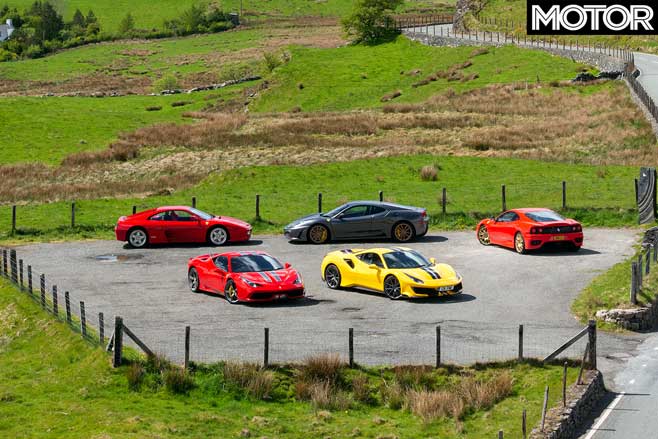
A gentle, warming trundle through the sleeping town pops us out onto the smooth, glistening sweep of a bypass. In the darkness, I’m tracking the glow of four pairs of round tail-lights, a constant of Ferrari’s mid-engined V8 model line – with the exception of the car I’m driving, a 348. This is no regular 348, though, because this is no gathering of regular V8 Ferraris.
Yowling along ahead are Ferrari’s feistiest and most focused production V8s – the 360 Challenge Stradale, 430 Scuderia, 458 Speciale and 488 Pista – and making up this full house of Maranello’s ‘special series’ V8s is the car I’m driving, the rarest of them all, the 348 GT Competizione. Just 50 were built and this is one of only eight right-hand drive examples.
So here we are, heading towards Denbigh in North Wales, in the UK, on shiny, black, empty roads. At least it has stopped raining. There are even tantalising glimmers of brightness in the dark sky, but as we drive further and climb higher, the temperature drops.
Soon there’s snow on the hills around us, bright in the headlamps. Happily, dropping down the other side, the snow vanishes and, almost miraculously, the clouds break as we approach our photo location and – ta-da! – we get a sunrise. Relief all round.
Ferrari 348 GT Competizione

I must confess the 348 GT Competizione wasn’t a car I’d been hankering to drive. How foolish of me. The GTC isn’t like other 348s; it doesn’t feel – and especially handle – like other 348s. Where the road dips and swerves invitingly, the GTC meets the challenge with poise to spare.
I’d never seen a GTC in the metal before collecting this immaculate example. It has a more purposeful stance than the standard model thanks to split-rim Speedlines, which are wider and an inch bigger in diameter. They wear plump Pirelli P Zeros and fill the arches so much better.
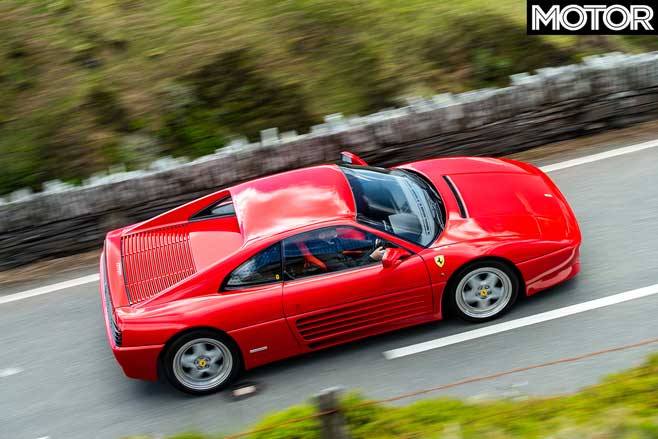
Swing open the lightweight carbon-skinned door and you see carbon-shelled F40 bucket seats. More carbon-kevlar is used for the front and rear bumpers and contributes to a claimed weight saving of almost 200kg, for a dry weight of 1180kg. This seemed rather optimistic, and when we popped it on the scales with half a tank of fuel, it came in at close to 1380kg. Still, there’s more to the GTC than weight reduction, and it drives beautifully.
Slot yourself into the driver’s bucket and the surroundings are familiar 348; all the regular fixtures and fittings are present, including carpets, door casings and Veglia dials. Compared with the others, it’s a small car, a feeling enhanced by the low scuttle and slightly raised driving position.
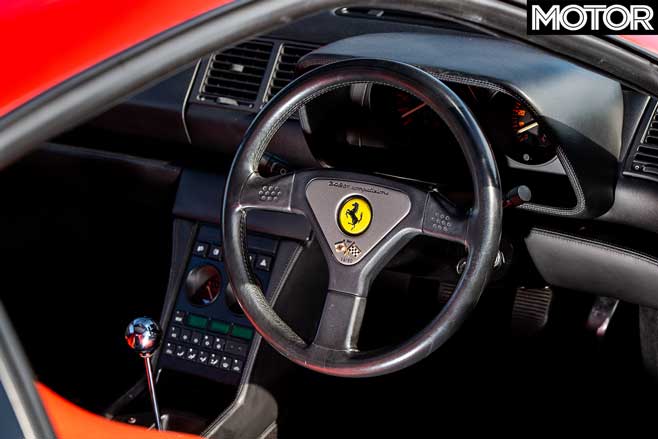
Plug the USB-like immobiliser tag into the steering column, hear the beep, twist the key and from over your shoulder comes a familiar, smooth, plain engine note. The GTC’s 3.4-litre V8 has the stock 239kW and, despite a different exhaust, initially doesn’t sound very different from stock either. Engagement is guaranteed, though, because sprouting from the open gate on the centre console is a tall gear lever topped with a shiny chrome ball.
The GTC is the only manual car here and is somewhat resistant to selecting second when cold. Adding to the challenge, initial throttle travel is rather sticky and the pedals are offset. Right away, though, the way it drives impresses; the ride is smooth and calm, though the sharp retort over cats’ eyes suggests it’s underpinned by some firm control.
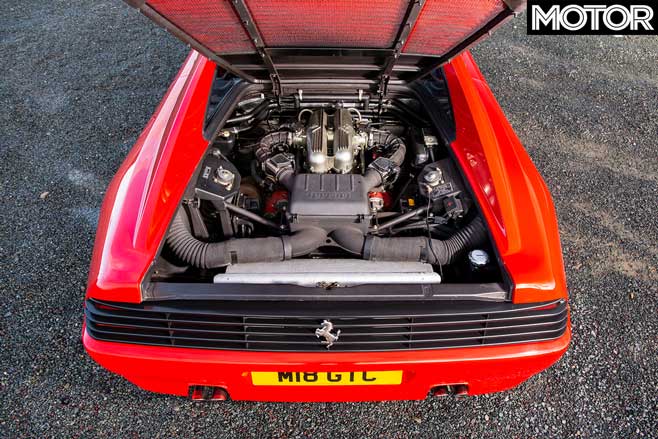
With everything thoroughly warmed, the engine is an absolute gem. It spins up so sweetly and so eagerly, and the delivery and note build to a zingy, rewarding top end. Shorter gearing certainly helps, and the gearshift is snappy and satisfying, but unquestionably the stand-out feature is its dynamics. It never seems to put a wheel wrong, even at a good pace across challenging roads. Crucially, there’s absolutely no suggestion that the back end is going to be an issue.
The unassisted steering is full of feedback and, although it becomes rather vague around the centre at speed, the GTC is always wonderfully accurate once guided into curves. Grip is strong, but it’s the damping that’s really special, managing to be relaxed for comfort but catching the car effortlessly through tricky sequences for seemingly undefeatable composure; you rarely feel the mid-engined mass.
The GTC isn’t just the best 348 I’ve driven, it’s one of the best mid-engined cars of its era.
Ferrari 360 Challenge Stradale
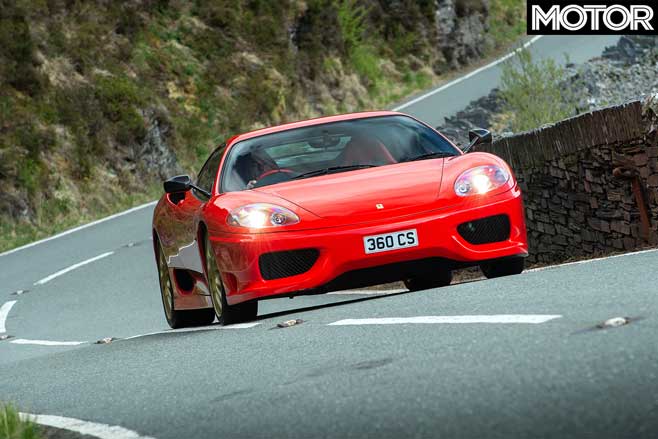
The step to the 360 Challenge Stradale is a big one for a few reasons, the first being that there was no stripped-down, toned-up version of the F355 that separates them. The second is that Ferrari completely reinvented the V8 model line with the 360 Modena in 1999, adopting aluminium monocoque construction and allowing the wind tunnel to dictate the proportions more than before.
There were race versions of the 360 before the Challenge Stradale came along in 2003 and, although it appeared to use racecar parts, particularly the carbon trim, it was in fact merely inspired by them. The Stradale was a bespoke, thoroughly engineered, dedicated road racer.
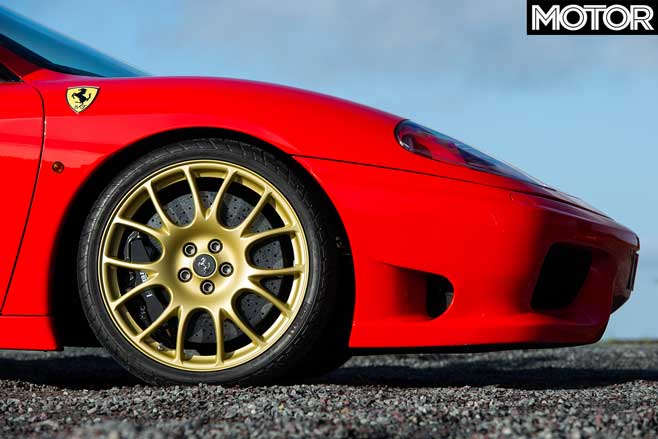
In effect, Ferrari blueprinted the 3.6-litre five-valve V8, lifting it just 15kW to 313kW, but there’s a lot more to the CS than that. There is a faster-shifting version of the single-clutch ‘F1’ automated manual, braking is by carbon discs and the interior is an exquisite confection of glossy carbonfibre, painted aluminium and Alcantara. The lack of soft furnishings gives a proper racecar feel and Ferrari claimed to have trimmed 110kg, which helped lop a massive 3.5sec off around Fiorano.
The Modena drove superbly but looked rather delicate on its slim front tyres. The Stradale sorts that out. Along with a lower ride height, wider tyres and gorgeous web-like alloys, its more sculpted front scoops look hungrier, and at the rear you can see the twin venturis bridged by the rear suspension arms. Proper stuff.
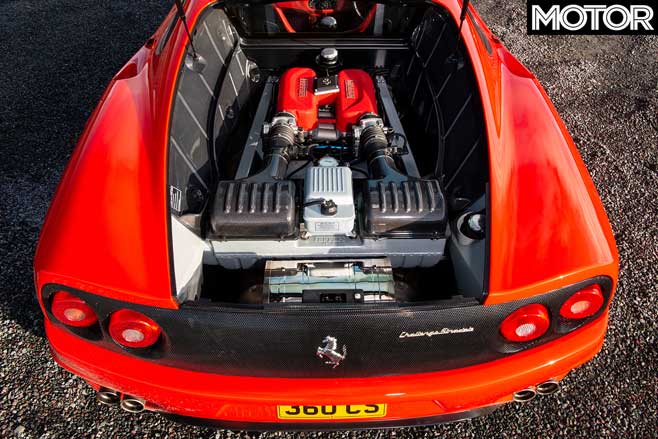
Drop inside and the beautiful leather-trimmed driver’s seat feels even better than it looks. The bucket is so comfortable, so cupping and laid-back that it feels like it has been moulded just for you, as does the steering wheel’s chunky, sculpted rim.
Through the vaguely quartic wheel you can see a large, central tacho, yellow-faced and redlined at 8500rpm but with numbers all the way up to 10, while in the mirror you can see the engine’s carbon airboxes, glossy in the light of the windowed engine bay.
Hit the big red start button and the Stradale’s V8 awakens. It has a deeper, more hollow bass tone than the 348’s, overlaid with a busy, lighter top note, and sends tremors through the floor and seat. Give the throttle a decent squeeze and it sounds like it’s in the cockpit with you. It thrives on revs, getting ever stronger as the needle climbs the dial, until you’re properly howling along.
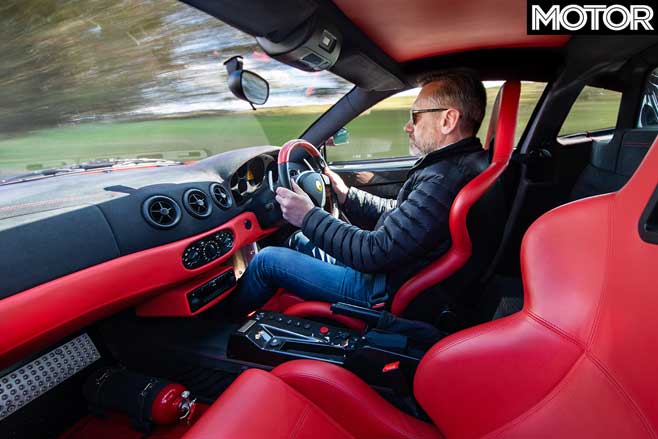
Even in this company it feels excitingly quick, though time has caught up with the gearbox. It’s great on downshifts, but you need to be positive with the throttle when manoeuvring to stop it dithering and give a mechanically sympathetic lift on upshifts to achieve the level of finesse we take for granted with modern DCTs.
You have to be mindful of the low nose on bumpy roads, but otherwise the Stradale’s dynamics deliver in spades. It’s firmly damped without being harsh and stays remarkably flat tacking into the corners, where you just know there will be huge grip from the Pirelli P Zero Corsas.
Initially, what’s most surprising after the 458 or 488 – or any recent Ferrari for that matter – is how relaxed the steering is, how slow the initial response, though you adapt quickly because everything else falls deliciously into place.
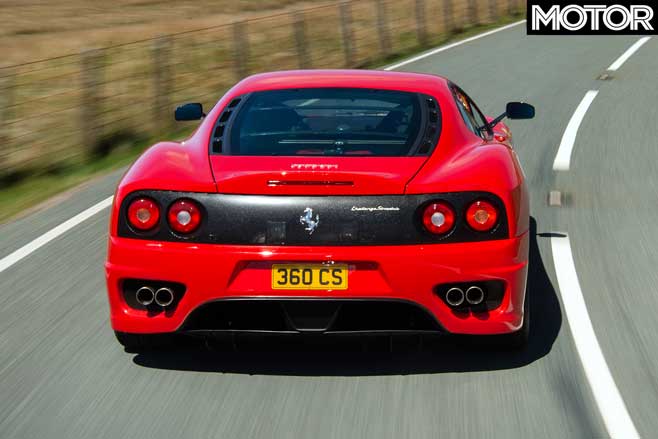
Up the pace, commit to a corner, and the nose locks onto the desired line and the Stradale settles deliciously into the apex. It’s a great feeling, and there’s such detailed feedback about the grip at either end that you know there’s more to be had, that it will be with you over the limit.
Lapping Fiorano years ago showed that the CS’s composure and control extend beyond the limit of grip, that it slips into power oversteer and back again cleanly, confidently, playfully. The only distraction is the howl of the V8; wrung out, the volume of noise is so great it feels like it’s about to burst at the seams.
Ferrari 430 Scuderia

As the last of the 1288 Stradales was being built, Ferrari was launching the 360 Modena’s replacement, complete with an all-new and much more powerful 32-valve 4.3-litre V8 delivering 360kW out of the box.
Though based on the 360, the F430 incorporated lots of new technology, developed with input from Michael Schumacher among others. It was the first Ferrari fitted with the manettino, allowing access to a number of pre-set dynamic characters. Another Ferrari first was the E-Diff, or electronic limited-slip differential, that could be finely manipulated – in conjunction with other adjustable features such as damping, throttle and gearbox response, and traction/stability control.
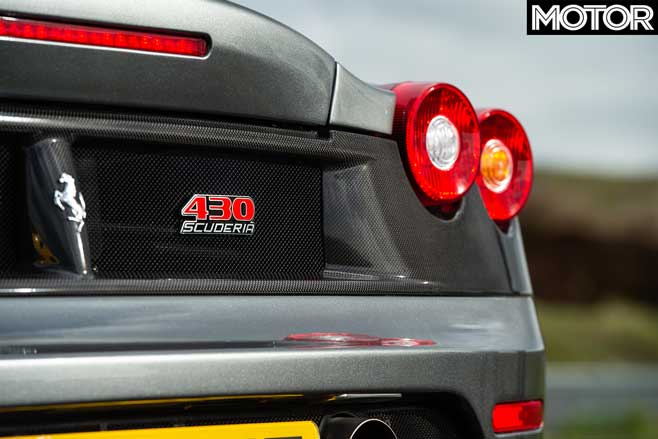
The Scuderia was launched in 2007 with 375kW, a gain of only 15kW, but a claimed weight saving of 100kg guaranteed blistering acceleration. Around Fiorano, the Scuderia matched the Enzo, by braking later and accelerating faster out of the turns. All the driver had to do was pin the throttle.
It sounds like a car that takes away all the skill and engagement. But, although there’s all this amazing on-limit ability, you don’t need to drive the Scuderia hard to enjoy and appreciate it. Indeed, evidence of its dynamic ability is the ‘Bumpy Road’ button on the steering wheel; this was the first Ferrari to have the separate damper switch, at Schumacher’s insistence.
It’s somehow not as racer-raw as the Stradale, despite having even more polished carbonfibre and exposed aluminium. Maybe it’s because the fascia – the whole interior, in fact – is a busier, more obviously fashioned fusion of shapes and materials. The Scud’s seats are just as well shaped as the Stradale’s, though, even if the ‘3D’ fabric of the centre panels looks like the breathable stuff you find on trainers.
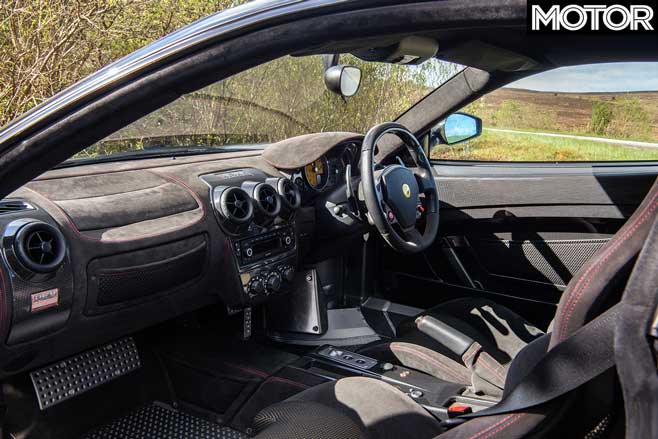
Twist the key, push the button and – boom! – the V8 lights up. The seat and floor zizz as they did in the Stradale, but the new F136 V8 has a smoother, tighter sound. It still blares like you’re too close to the speakers at a concert, but the volume matches throttle demand, so you can make relatively stealthy progress.
There’s a simmering energy suffusing the Scuderia, a pent-up urge to cut loose. It’s there in the ease with which the V8 revs and the keenness of the gearbox to shuffle down the gears. Ferrari really nailed the automated, single-plate manual gearbox with the Scuderia.
Dubbed F1 SuperFast2, at its swiftest this final iteration of the automated manual could change gear in just 60 milliseconds. But it’s not just the shift speed that impresses, its finesse is good too, its speed matched to throttle demand. Sure, the fastest upshifts still jolt, but most of the time the ’box does exactly what you expect and doesn’t draw attention to itself.
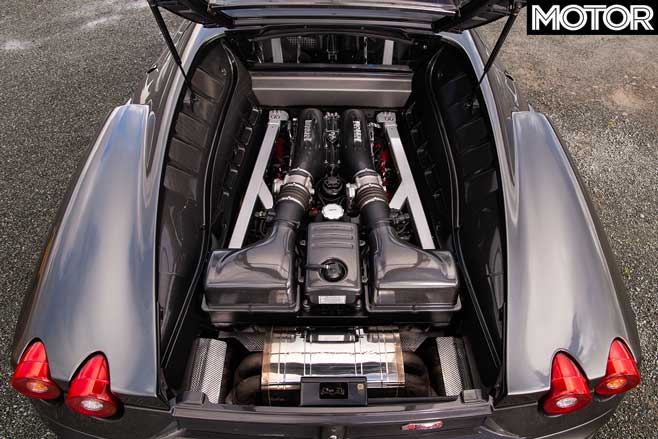
The same is true of the dynamics. There’s an awful lot the electronics can do to enhance its behaviour, but most of the time they’re not intervening because at its core the Scuderia is a beautifully sorted driver’s car. Its steering is feelsome and more instantly responsive than the Stradale’s and, while it’s still not super-sharp, it’s direct enough for me. The ride is taut, but Bumpy Road mode adds suppleness.
It feels slightly narrower than the Stradale, though this doesn’t affect its cornering ability. There’s the same sensation of endless grip at a decent pace, and when you let the engine have its head the pace is shockingly fast, but the chassis easily meets the challenge.
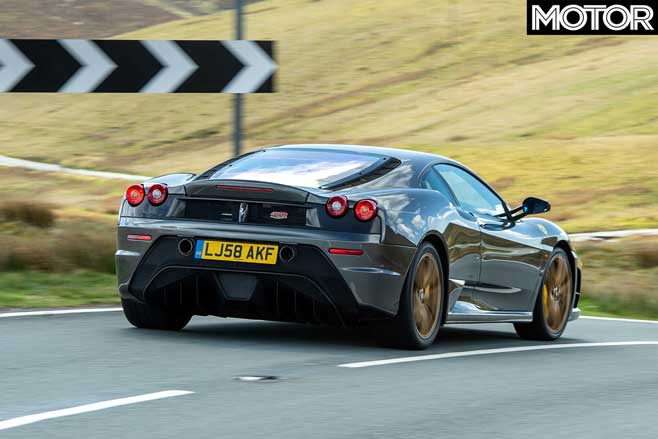
On a dry, warm road, the Scuderia’s poise, precision and control are astonishing. It might be pushing 12 years old now, but there’s absolutely nothing old-fashioned about the way it tackles a technical stretch of asphalt, without any obvious electronic interventions. It simply feels very positive, perfectly balanced and very effective, with terrific grip and corner exit traction. Best of all, you feel you’re at the heart of it, calling the shots. It’s sensational.
Ferrari 458 Speciale
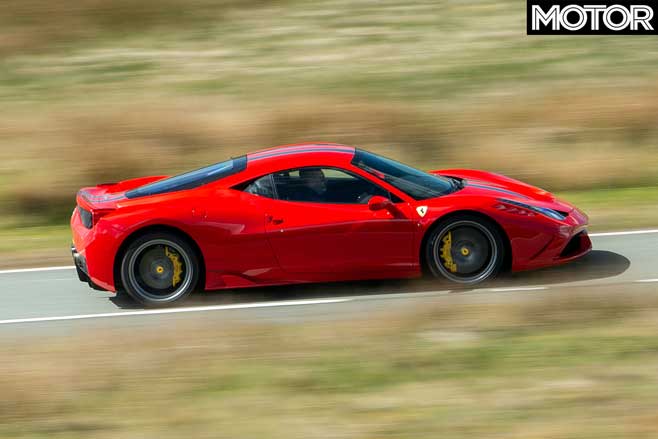
The 458 Speciale was extraordinary in 2013 and we now know it’s unlikely there will ever be anything quite like it again. The 458 Italia had already ramped things up, introducing a 4.5-litre, direct-injection evolution of the F430 engine that hiked power to a remarkable 419kW, but the Speciale took things even further.
With a host of refinements – including raising the compression ratio from 12.5:1 to 14.0:1, changing the cam profiles and redesigning the piston tops and intake system – power went up to an astonishing 445kW, giving this V8 the highest specific output (99kW per litre) of any naturally aspirated production engine.
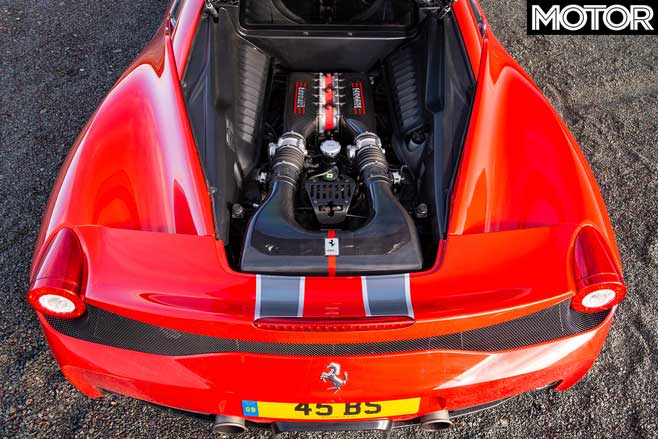
It’s an incredible powerplant. It revs to 9000rpm, and there’s a thrill when you get to 7000rpm. Most engines hit the buffers, but the Speciale’s V8 kicks on, its note mutating and becoming even more urgent as it surges for the redline. It’s a crazy, spine-tingling experience. Addictive too, especially as the 458 swapped the automated manual for the heavier but incredibly slick F1 DCT dual-clutch transmission, which gives almost seamless upshifts, even at 9000rpm.
Even more technology further refined the car’s behaviour generally, but especially in extreme situations. So there were magnetorheological dampers, faster control of the E-Diff and traction control, and a new feature called SSC – side slip control – that helps keep a slide in balance if you’re bold enough to twist the manettino round to Race or CT Off.

The steering rate was ramped up by about a third compared to the F430, and you might imagine this directness and the engine’s incredible power and appetite for revs would leave you frazzled after a fang. But you quickly adapt your steering inputs and realise that this incredible atmo engine can be finely controlled by your right foot.
I turn all the aids off and revel in its control, the way it settles into corners, the tactility of the steering. The feedback and feel as you energise the rear tyres with a squeeze of throttle ahead of the apex is absolutely glorious.
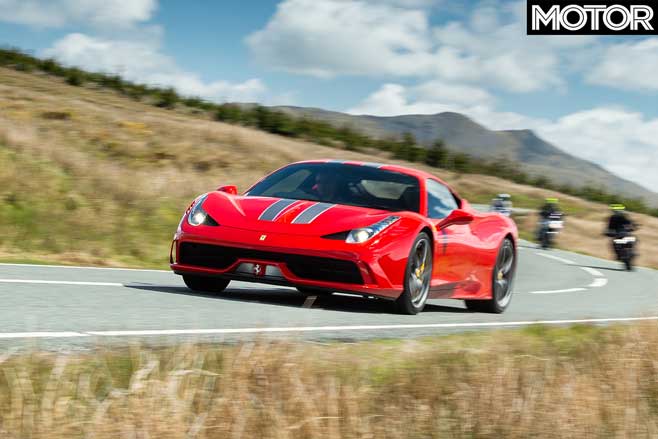
Passengers seemingly don’t cope well with it, feeling the escalating shove in the back, or the lateral g building, hearing the frantic, slightly hysterical howl of the engine and thus fearing that oblivion is but an ill-judged throttle squeeze or flick of steering away. Yet from the driver’s seat the Speciale feels unshakably composed, with an effortless poise at odds with the engine’s manic ebb and flow as the road alternately tightens and opens up.
It’s slightly surreal, feeling so calm as you wring out a 445kW V8 to 9000rpm. At one point I caught myself musing what it would be like with a little more mid-range torque…
Ferrari 488 Pista

The answer to that last musing is provided, partly, by the 488 Pista. Only partly because the adoption of twin turbos for the new 3.9-litre V8 doesn’t bring a little more mid-range torque, it brings a truckload. The Speciale’s peak is 540Nm at 6000rpm; the Pista delivers 770Nm at 3000rpm – that’s getting on for 50 per cent more at half the revs.
You’d think this would fundamentally change the way the Pista drives compared with its predecessors, but it doesn’t. It’s true to special-series values, not only by being 100kg lighter than the stock 488 GTB but by having the same intimate relationship with the road. The damping is fabulous, the whole car settling into an apex four-square, massive grip from the Cup 2s holding the exact line.

You would expect the readily available torque to make things different on exit, and it can if you want it to, but for a turbocharged machine the Pista has great throttle response. You can mete out the torque so that the exit is smooth and orderly, or you can twist the manettino, light up the rears and apply a twist of opposite lock.
All the aids are there, even further refined to cope with the torque uplift, so help is at hand when it’s required, though sometimes perhaps not quite as readily as you might hope.
It’s a phenomenally fast car, delivering its peak of 529kW at 8000rpm, but there are some things missing, particularly after the Speciale, the first being a thrilling engine note. After a promising, bassy start-up and idle, the sound seems to get lost in the plumbing for the two turbochargers.
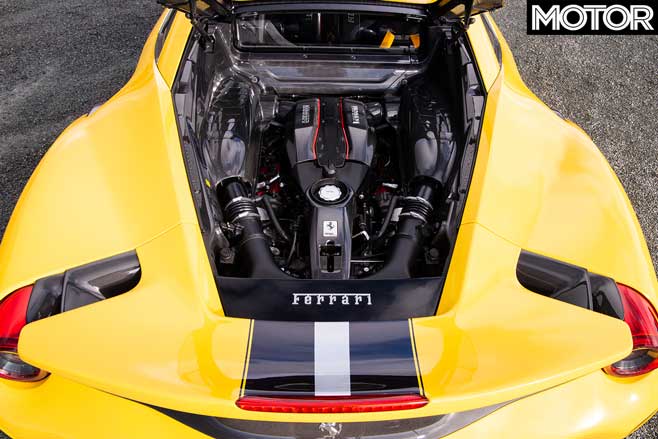
The second is throttle response; it’s very good, but after the vernier precision of the Speciale and Scuderia, you notice a momentary pause before getting what you asked for. And while the Speciale was unexpectedly, staggeringly driveable in poor conditions, you have to tread carefully in the Pista on a wet road, or even when the Cup 2s are just cold, because a thoughtless stab of throttle will momentarily unstick the rears, even with traction control.
In the right conditions, though, the Pista can cover the ground at a staggering pace – and engage and immerse you in the process, challenging and rewarding like any of these super-series cars. It takes a little longer to build up the confidence, to get the measure of how it will respond, but it’s a mighty buzz when you’re riding the throttle with a twist of opposite lock and still moving forwards at a rate. It’s pretty much how a modern-day F40 would feel.
Verdict – Which is the best track-focused V8 Ferrari?
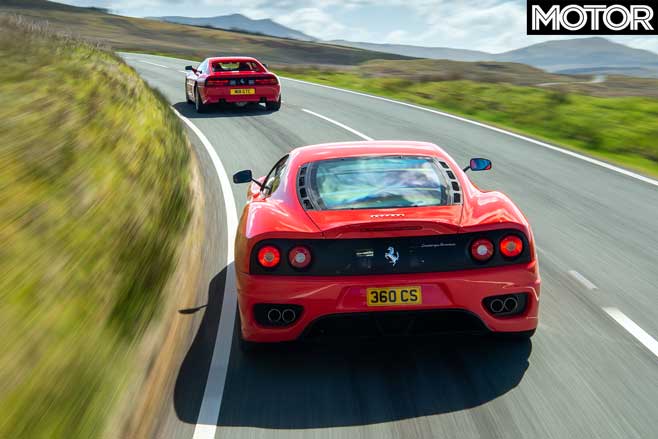
Is it possible to pick just one car from this five? Probably not, but in many respects the Challenge Stradale is the high point. With the barest trim and sportiest options – aluminium roll hoop, fabric seat covers, harness belts, sliding Lexan side windows – it really does look and feel like a road-going racecar. None of the others here evoke that in quite the same way. It lives up to its name.
The Speciale does too, not least by having the ultimate Ferrari aspirated V8. Awesome is an overused word, but it’s an apt description of the sound and fury of this engine revving flat-out to 9000rpm. Yet it’s a very easy supercar to exploit, being perfectly well mannered and having a sublime chassis. An amazingly usable car, already worthy of legendary status.

The 348 Competizione has little more than half the Speciale’s power, but what a sweet surprise. Unassisted steering, manual gearshift, no electronics for stability or traction… it’s tactile and capable and puts a smile on your face with its ability to flow over difficult roads, poised and precise. Underrated and overlooked. A 348 like no other.
The fact that the Pista – a 529kW, twin-turbo, mid-engined, rear-wheel drive supercar – can be driven with all aids off, dancing on the limit of grip, shows that Ferrari consistently nails the basics. Yet its throttle response and delivery make it a different sort of special series car.
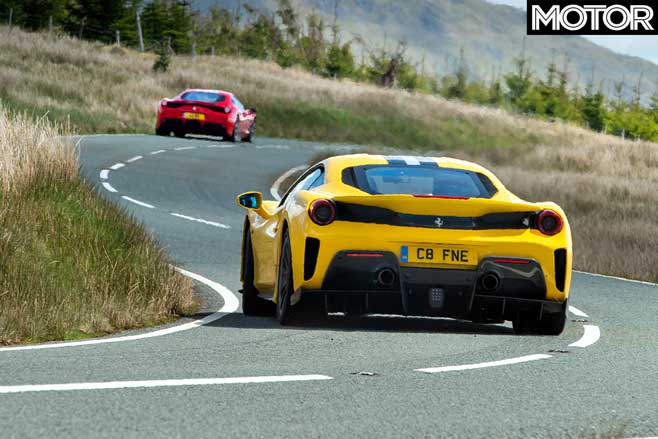
For me, the Scuderia is the absolute sweet spot. It’s not as futuristic-looking as the 458 or 488 and its gearbox isn’t as slick, but it doesn’t feel old. It is ferociously fast – as fast as you’ll ever need – and dynamically as engaging and rewarding as any car here. It also happens to be undervalued. Though not for long, I confidently predict.
Fast Facts
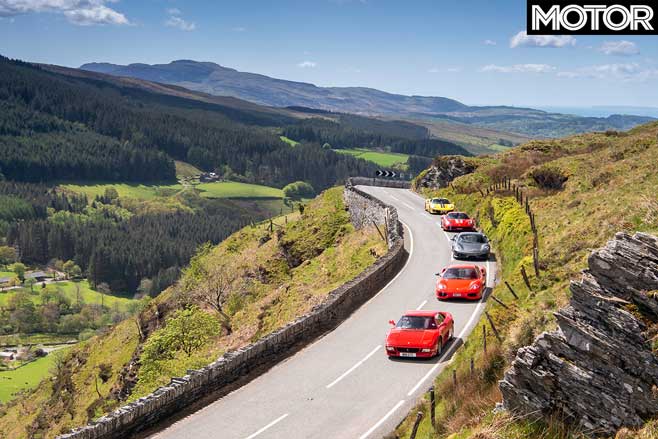
| u00a0 | Ferrari 348 GT Competizione | Ferrari 360 Challenge Stradale | Ferrari 430 Scuderia | Ferrari 458 Speciale | Ferrari 488 Pista |
| Body | 2-door, 2-seat coupe | ||||
| Drive | rear-wheel | ||||
| Engine | 3404cc V8, DOHC, 32v | 3586cc V8, DOHC, 40v | 4308cc V8, DOHC, 32v | 4497cc V8, DOHC, 32v | 3902cc V8, DOHC, 32v, twin turbo |
| Power | 239kW @ 7200rpm | 313kW @ 8500rpm | 375kW @ 8500rpm | 445kW @ 9000rpm | 529kW @ 8000rpm |
| Torque | 324Nm @ 5000rpm | 373Nm @ 4750rpm | 470Nm @ 5250rpm | 540Nm @ 6000rpm | 770Nm @ 3000rpm |
| Power/Weight | 203kW/tonne (dry) | 245kW/tonne | 278kW/tonne | 319kW/tonne | 382kW/tonne |
| Transmission | 5-speed manual | 6-speed automated manual | 7-speed dual-clutch automatic | ||
| Weight (dry) | 1180kg (dry) | 1280kg | 1350kg | 1395kg | 1385kg (w/ lightweight options) |
| Suspension (f) | double wishbones, coil springs, telescopic dampers, anti-roll bars | double wishbones, coil springs, adaptive dampers, anti-roll bar | |||
| Suspension (r) | double wishbones, coil springs, telescopic dampers, anti-roll bars | double wishbones, coil springs, adaptive dampers, anti-roll bars | multi-link, coils, adaptive dampers, anti-roll bar | ||
| Steering | unassisted rack-and-pinion | hydraulically assisted rack-and-pinion | |||
| Brakes (f) | 300mm ventilated discs | 380mm vented carbon-ceramic discs | 398mm vented carbon-ceramic discs | 398mm carbon-ceramic discs | |
| Brakes (r) | 305mm ventilated discs | 350mm vented carbon-ceramic discs | 351mm vented carbon-ceramic discs | 360mm carbon-ceramic discs | |
| Wheels | 18 x 8.0-inch (f); 18 x 10.0-inch (r) | 19 x 9.0-inch (f); 19 x 13.0-inch (r) | 19 x 7.5-inch (f); 19 x 10.0-inch (r) | 20 x 9.0-inch (f); 20 x 11.0-inch (r) | |
| Tyre Sizes | 225/40 ZR18 (f); 265/40 ZR18 (r) | 225/35 ZR19 (f); 285/35 ZR19 (r) | 235/35 ZR19 (f); 285/35 ZR19 (r) | 245/35 ZR20 (f); 305/30 ZR20 (r) | |
| 0-100km/h | 5.0sec (est) | 4.1sec (claimed) | 3.6sec (claimed) | 3.0sec (claimed) | 2.85sec (claimed) |
| Top Speed | 282km/h (est) | 299km/h (claimed) | 319km/h (claimed) | 325km/h (claimed) | 340km/h (claimed) |
| Value today | $280,000-plus | $400,000-$650,000 | $250,000-$400,000 | $450,000-$700,000 | $700,000-plus |
Five Fast Facts: Ferrari V8s

01 – It all started with Lancia Ferrari’s first V8 engine was a 2.5-litre unit derived from the Lancia engine used in the 1950s D50 Formula One car
02 – The engineer who made his mark Engineer Carlo Chiti worked only briefly for Ferrari, but designed the 1.5-litre V8 that won the world F1 title in 1964
03 – The Dino V8’s 30-year reign The 3.0-litre ‘Dino’ V8 ran for 30 years, from 1974 with the 308 until the 360 Modena in 2004, when it was 3.6 litres
04 – Italians unite for a new V8 Ferrari and Maserati jointly developed the F136 V8 series, which Ferrari put into the F430, California and 458 Italia
05 – Making V8s for Formula One From 2006 to 2013 the F1 regulations required 2.4-litre V8s. Ferrari won the 2007 and 2008 constructors’ titles

